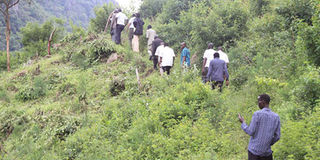Mystery of beacon removed from Tugen Hills

Domestic tourists visit Saimo Forest in Baringo County. Locals consider it a sanctuary, calling for its preservation. PHOTO | FLORA KOECH | NATION MEDIA GROUP
What you need to know:
- The forest is also home to a lone tree locally known as kapkoros, which was considered a sacred place where marriage negotiations and other rituals were carried out.
- Mr Bett, who led more than 200 professionals in planting indigenous trees in the forest, warned those wantonly destroying the water tower that they risk being jailed.
Hidden in the steep Tugen Hills is Saimo Forest, which hosts an important but little-known historical site known as Kapchumba.
The area’s history is closely associated with Joseph Thomson, a Scottish geologist and explorer who planted a beacon on top of the hills more than a century ago when he crossed the forest on his way to Laikipia.
The beacon, an important part of the history of the forest, was removed 15 years ago by British High Commissioner John Johnson.
“Sir John Johnson, a British high commissioner, travelled all the way here after he was asked by his government to trace the beacon planted by Mr Thomson. He traced two beacons with the help of the locals and he removed it, taking with him some information that was hidden beneath it,” said Eric Bett, a resident.
“The place called Kapchumba, where geologist and explorer Joseph Thomson erected a beacon when he passed here, is named after him,” adds Mr Bett.
A SANCTUARY
The Thomson’s gazelle and Thomson’s Falls in Nyahururu are also named after Mr Joseph Thomson.
Locals believe that the site is the highest point in the country, and that hundreds of years ago, when technology was not very advanced, a metal was erected at the tip of the hill to help planes overflying the area.
“We hear the metal was mercury, and that it was used to help planes overflying the area. Many people will recall that sometime back, planes used to go up the Saimo Hill, and we believe the metal pointed directions to them,” says Ambrose Keitany, a resident.
“This area is 2,400 metres above sea level, the same altitude as Kapsowar and Iten in neighbouring Elgeyo Marakwet County. We are thinking of setting up an athletics training camp here. It would be ideal,” adds Mr Keitany.
Local leaders are now rooting for the conservation of the sanctuary and sacred forest; there are reports that sections are being destroyed through illegal logging.
“As professionals from this region, we are launching a complaint because a lot of our historical sites have been destroyed. The beacon was one of them,” he adds.
GREAT VIEW
According to Mr Keitany, the tip of Saimo Forest is the highest point of the Tugen Hills in Baringo County.
“Joseph Thompson and his team also constructed a tower on the tip of the hill, from where you could get a clear and spectacular view of Mt Kenya, Mt Elgon and Nakuru Town. Sadly, the tower has also been destroyed.
This place was a campsite for the wazungu (Whites), whom our Kalenjin people refer to as Chumba, and that is why it ended up being named Kapchumba. They liked camping here because of the high altitude,” said Mr Bett.
The forest is also home to a lone tree locally known as kapkoros, which was considered a sacred place where marriage negotiations and other rituals were carried out.
“There were some sacred trees in the forest that were used to carry out rituals, traditional ceremonies and marriage negotiations. Sadly, most of them have been felled by the locals. We are disappointed that a forest that used to be home to hornbills, colobus monkeys and baboons has been destroyed,” Mr Bett said during a tour of the forest last week.
CONSERVATION
Mr Bett, who led the more than 200 professionals in planting indigenous trees in the forest, warned those wantonly destroying the water tower that they risk being jailed.
“We are giving ultimatum to the forest officers and government officials who are colluding with the locals to fell of indigenous trees in this forest that their days are numbered,” said Mr Bett.
Residents are now calling on the government to outlaw the harvesting of indigenous trees in the forest, which is also the source of all the rivers in the vast region.





